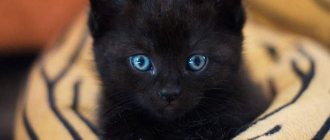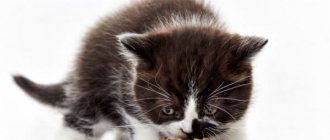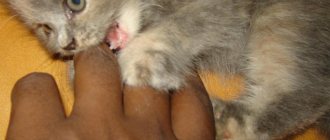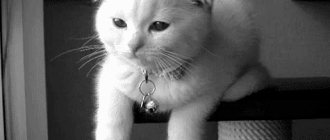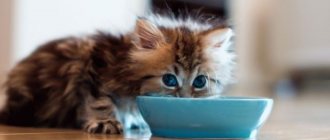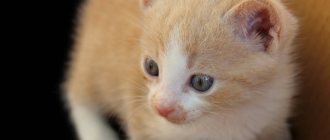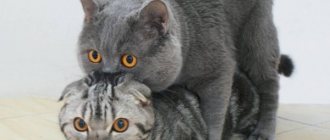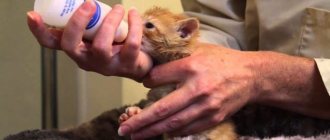As pet owners, we want to witness our cats' life milestones. Kittens grow quickly in the first months of life, but the question is: when does a kitten become a cat?
A kitten is considered an adult cat when it reaches one year of age . Time flies and before you know it, you already have an adult cat at home. Cats develop physically at a rapid rate, but it takes a lot of patience and care before your kitten becomes a full-fledged cat.
Life stages of a cat
The life of a cat is usually divided into several stages, depending on its age: childhood, adolescence, youth, maturity and old age.
Childhood (up to 6 months)
The most dramatic changes occur during this period. In the first month of life, the concepts of sleep and kitten are almost inseparable. At this stage, he is helpless and needs a mother who can protect, feed and warm him.
By five months, the kitten increases significantly in size. Despite his physical growth, he is still a child who understands little but wants to try everything. The pet becomes very curious and active.
It should be understood that accustoming a kitten to a tray, scratching post, bed and much more needs to start from a very early age.
Read more: What does a kitten owner need to know?
Youth (7 months – 2 years)
At six months, the kitten looks completely different. He becomes graceful and confident. He orients himself well in space, but is still playful and curious.
At ten months, he already reaches puberty and begins to be interested in the opposite sex. It is best to sterilize your pet at this age; this will have a beneficial effect on his health. In addition, this way you will definitely not become the culprit of the next replenishment of the army of stray animals.
Read more about the benefits of sterilization: Sterilization is a recognized necessity
But, again, despite his mature appearance, he should not be considered a fully formed cat. The kitten will continue to grow for at least another eight months.
At one and a half years old, a cat stops growing physically. The pet changes dramatically: it becomes mature, majestic, and graceful. Stops doing stupid things, but still wants to play and spend time with you.
Youth (from 3 to 6 years)
This is a kind of peak of cat development: she is healthy, active, socialized.
Maturity (from 7 to 14 years old)
The cat is active, cheerful and full of energy. Now he has life wisdom, so he reacts much calmer and more restrained to surrounding stimuli and changes. Closer to the age of 14, he becomes calm and slow.
Old age (from 15 years old)
At this time, cats become more sedate, more in need of their owner’s care, and are more affectionate and loyal to him than ever. Older cats tend to be less active and less curious. Your cat will no longer rush around the apartment, jump through cabinets and frantically chase toy mice. Now your initiative will be required: either move the fishing rod or play catch-up.
By the way, several decades ago the life expectancy of cats was much lower - 12-year-olds were already considered long-livers. Man has improved the quality of life of pets, and with it, its duration has increased. Moreover, much - one and a half to two times. That's why today about 37% of domestic cats reach 20 years of age. What can we say about the record-breaking cat, who was entered into the Guinness Book of Records at the age of 38.
Read more: How many years do cats live?
The final maturation of the kitten
As practice shows, a cat becomes an adult by about 18 months of age, regardless of the individual characteristics of the animal. At this stage, cats are fully formed not only physically, but also socially. This statement does not apply to sterilized animals. Such cats, due to hormonal changes in their bodies, are characterized by more “childish” behavior. They can be more playful and spontaneous than unsterilized cats.
Many people are surprised by the fact that adult cats retain the same playfulness and curiosity as kittens. In fact, this is completely normal. Cats are very active and mobile animals, so it is not at all shameful for them to show playfulness and curiosity even at an advanced age. Such behavior for an animal is not at all a sign of insufficient maturity.
Source
Reasons for slow growth
The size to which and how a kitten will grow is determined by its heredity, that is, its genes. But in order for the opportunities inherent in nature to be realized, favorable external conditions are necessary. The main reasons why a kitten may be stunted:
- Poor nutrition. A kitten can be well-fed and well-fed and at the same time its growth may not correspond to the parameters of the breed. Why is this happening? During a period of intensive growth, the body needs a certain amount of not just nutrients or calories, but the quality composition of the food received is of great importance. The daily diet must contain the right amount of components important for growth: vitamins, proteins, calcium and phosphorus. Therefore, you should not neglect the recommendations of specialists; you need to adhere to a certain diet, taking into account the breed and age of the kitten. Only in this case will he realize the growth opportunities inherent in nature. In addition, proper nutrition greatly affects the health and immune system status of any animal.
- Diseases. It is clear that during the period of intensive growth, it is necessary to protect the young animal from the possibility of contracting infectious diseases. The owner must provide his pet with all necessary vaccinations and treatments in a timely manner. A common cause of stunting is helminthic infestations, to which young animals are very susceptible.
- Hormonal changes. Growth rates may be affected by the time of spaying or neutering, so you should discuss the issue with your veterinarian before surgery.
Thus, if you want to raise a beautiful animal whose constitution will correspond to the breed criteria, you need to devote some time, mainly to self-education in matters of feeding and maintaining your pet. And we must remember that omissions during a period of intensive growth are difficult to compensate for in the future, and often impossible.
Cute video: How a kitten grows
https://youtube.com/watch?v=jAASLCqhw1w
Age at which a kitten is still considered a kitten
As pet owners, we want to witness our cats' life milestones. Kittens grow quickly in the first months of life, but the question is: when does a kitten become a cat?
A kitten is considered an adult cat when it reaches one year of age . Time flies and before you know it, you already have an adult cat at home. Cats develop physically at a rapid rate, but it takes a lot of patience and care before your kitten becomes a full-fledged cat.
Determining the age of a cat by the condition of its teeth
A particularly effective method for determining a cat’s age is by looking at its teeth in the first months of their life, since the replacement of baby teeth with molars follows a fairly strict schedule. Subsequent changes in the condition of the enamel and the strength of the teeth themselves also obey certain rules, but have their exceptions to the rules.
Despite their strength, without proper care, cat fangs quickly become coated with plaque.
The fact is that in addition to the number of years spent in the cat’s jaw, the condition of the teeth is also influenced by such factors as:
- Lifestyle.
The teeth of a well-groomed domestic cat that does not neglect visiting the dentist will be strikingly different from the teeth of a stray cat of the same age. Care allows both human and cat teeth to maintain a neat appearance and high functionality for a long time; The need to grind teeth on unsuitable materials leads to their rapid wear - Heredity. It is known that all breeds have certain weaknesses. Some breeds have jaw abnormalities and simply weak teeth, which are passed on from generation to generation until your pet gets it. In this case, the condition of the teeth may even age him and not provide correct information about his age.
The “life path” that each cat’s teeth go through is presented in the table below.
Table 1. Age-related changes in cat teeth
| Age | Dental condition |
| Three to five weeks | The first baby teeth appear |
| Six months | Baby teeth are completely replaced by molars |
| One year | At this age, your teeth are in the best possible condition. There are no tartar or yellow plaque |
| One and half year | The first, barely noticeable signs of wear appear on the cat's teeth, consisting in the abrasion of the central incisors of the lower jaw. |
| Two years | Tooth enamel begins to acquire a yellowish tint, tartar and other dental deposits gradually accumulate |
| Four to five years | The wear of the central incisors is pronounced; the middle incisors suffer the same fate. |
| Five to six years | Upon closer examination, abrasions on the fangs are visible. The outer incisors of the upper jaw are subject to wear. There are disruptions in the pigmentation of tooth enamel, resulting in yellowish and dark spots |
| Seven years | All existing incisors are worn out (some may have fallen out), and abrasions on the fangs are clearly visible |
| Ten years | The cat is experiencing gradual tooth loss. First, as a rule, the central incisors become unusable, then it comes to the middle and extreme ones. |
| Fifteen years | If a cat lives to this age, then she has to come to terms with the loss of fangs - one of the means of effective self-defense |
Learn more about maintaining dental health
As you can see, the age of a cat has a significant impact on the condition of its teeth. The lifestyle an animal can afford depends on the health of its teeth. Unfortunately, it is rare that an owner is puzzled by the condition of his pet’s teeth, wanting to choose the right type of food for him. Meanwhile, it is enough for the pet owner to show it to a specialist from time to time and consult about the condition of the animal’s teeth in order to avoid their premature wear.
The condition of the oral cavity influences the choice of the appropriate type of food
To maintain strong teeth and a clean mouth, special “dragées” may be prescribed, which must be chewed thoroughly. In some cases, owners are advised to use special toothpaste to prevent caries and stones.
Timely removal of tartar will allow your pet to keep its teeth.
How to determine how old a cat is
By some external signs you can easily determine the age of a cat. For example:
- In the teeth. After three months of life, kittens' milk teeth are replaced with permanent teeth. For up to one and a half years, cats and kittens retain the white color of their teeth, after which the tooth enamel begins to turn yellow. After 3 years of life, tartar begins to appear on the animal’s teeth. After ten years of life, the central, middle, and then the outer incisors begin to fall out. By the age of 15, a pet's fangs will fall out.
- By puberty. Males and females become sexually mature after six months of their life. It is during this period that they begin to mark the territory with a secretion that has a very unpleasant odor.
- According to the nature of the coat. Younger animals have soft and thin coats, compared to older animals whose coat becomes coarse and becomes lighter or darker. In an older animal, you can already see something like gray hair, which appears in the form of individual hairs or entire lightened spots.
- By the eyes. Young cats and cats have fairly clean and clear eyes, which cannot be said about older animals whose eyes become cloudy with obvious signs of pigmentation disorders within the irises.
To more accurately determine the age of animals, there are a number of formulas and tables.
| Age of the cat | Person's age |
| One year | 7 years |
| Two years | 14 years |
| Three years | 21 years old |
| Four years | 28 years |
| Five years | 35 years |
| Six years | 40 years |
| Seven years | 45 years |
| Eight years | 50 years |
| Nine years | 55 years |
| Ten years | 60 years |
| Eleven years | 65 years old |
| Twelve years old | 70 years old |
| Thirteen years | 75 years old |
| Fourteen years old | 80 years old |
| Fifteen years | 85 years old |
| Sixteen years | 90 years old |
| Seventeen years | 95 years old |
| Eighteen years | 100 years |
Which information is more accurate?
According to many experts, the information given in the following table is considered the most accurate.
| Age of the cat | Person's age |
| One year | 15 years |
| Two years | 24 years old |
| Three years | 28 years |
| Four years | 32 years old |
| Five years | 36 years |
| Six years | 40 years |
| Seven years | 44 years old |
| Eight years | 48 years old |
| Nine years | 52 years old |
| Ten years | 56 years old |
| Eleven years | 60 years |
| Twelve years old | 64 years old |
| Thirteen years | 68 years old |
| Fourteen years old | 72 years old |
| Fifteen years | 76 years old |
| Sixteen years | 80 years old |
| Seventeen years | 84 years old |
| Eighteen years | 88 years old |
| Twelve years | 92 years old |
| Twenty years | 96 years old |
Each cat breed has its own life expectancy data. For example:
- The Snowshoe breed lives on average about 11 years.
- The Bombay cat can live for at least 12 years.
- The Russian Blue cat lives for at least 13 years, as does the American Bobtail.
- Scottish Straights, Rex cats and York chocolate cats reach an age of about 14 years.
- Sphynxes, Persian cats, as well as the Abyssinian cat and the British Shorthair live up to the age of 15 years.
- The Maine Coon breed lives no more than 16 years.
- The Australian Smoky and Neva Masquerade will live at least 17 years.
- Cats such as Tiffany and Japanese Bobtail will live about 18 years.
- An Asian tabby can live for about 19 years.
- The American Shorthair and Manx live within 20 years.
Cat breeds such as Thai and Siamese are also long-lived.
Genetic abnormality
Very rarely, the reason that a kitten does not grow and does not gain weight can be a genetic anomaly, which results in dwarfism of the animal. As a rule, these are babies abandoned in early childhood by their mother cat, who have visible defects in skeletal development. Such a kitten does not grow due to underdevelopment caused by the mutation.
In conclusion, it only remains to add that, regardless of the cause of growth retardation, you should not self-medicate, especially if there is an infectious disease or the kitten is not growing due to pathology of the internal organs. At the first signs of illness, you should contact a veterinarian who will conduct a full examination and prescribe treatment.
Did you like the article and was it useful? Please share with your friends.
___________________________________
When does a kitten stop growing?
Kittens will have a rapidly growing body from the day they are born until the first six months of life. After this, your cat's growth will slow down. Most cats reach their full size by one year of age, the same time they become adults. However, this depends on the breed and health of the kitten.
Even if a cat reaches its full size, this does not mean that it will behave like an adult. Most cats will be cheeky and teenage-like in the first 8 to 12 months of their lives.
Please note that nutrition plays an important role in a kitten reaching its full body size. You must provide your kitten with a balanced diet so that he grows up strong and healthy. However, it would be best if you monitor your kitten's weight, as some breeds have a high risk of obesity.
Obesity is very unhealthy, especially for cats because they love to climb and jump off surfaces. Excess weight will crush your kitten's joints and increase the risk of developing orthopedic problems.
Kitten weight table by month
The first 6 months are important for a cat's development. The kitten needs to be provided with proper care and a balanced diet.
This determines his body type, weight gain and the degree of development of skeletal muscles. Stages of development of this cat breed:
- The first days after birth. The kitten's body weight reaches 70-130 g. At the age of up to 1 week, kittens quickly gain weight and become 1.5 times heavier. A cat that has recently given birth to kittens is provided with nutritious food. She needs to eat more vitamins and minerals to make her milk healthy for her newborns.
- 2 weeks. The weight reaches 110-150 g. After 7 days, the figure doubles and amounts to 210 g. The kittens remain blind and have low physical activity. They need proper nutrition and sleep. Body size is 9-14 cm.
- 1 month. Complementary foods are introduced: canned fish, chicken fillet, a small amount of beef, cottage cheese and yolk. By the end of 30 days, kittens gain up to 450-470 g. At 2 months, the weight already exceeds 750 g.
- 3 months. The normal weight of a kitten is 1000-2000 g. If it continues to feed on its mother's milk, it should not be separated from the cat. In this case, he still requires nutrients, vitamins and minerals that he cannot absorb through food. It is recommended to diversify complementary foods. You can give pork, chicken breast, and fermented milk products with a high percentage of fat. It is allowed to include in the diet high-quality food from the EVO or Hills brands, which specialize in feeding young animals.
- 4 months. The female should weigh 1700-2400 g, males - from 2.1 to 4 kg. At this age, the kitten quickly gains weight, so it is necessary to prevent the development of obesity. It is recommended to play more with the animal. If its weight is more than 4 kg, the amount of feed must be reduced.
- 5 months. Body weight increases 2 times. The normal weight of the animal is 4.5 kg. Before growing up, the cat needs to gain another 3-4 kg.
British kitten weight by month:
| Animal age | Female body weight, g | Male body weight, g |
| Newborns | 60-140 | 70-140 |
| 1 Week | 110-250 | 150-260 |
| 2 weeks | 170-360 | 350-400 |
| 3 weeks | 220-430 | 400-650 |
| 4 weeks | 250-600 | 550-750 |
| 8 weeks | 450-900 | 1000-1700 |
| 12 weeks | 1000-1300 | 1500-2500 |
| 16 weeks | 1800-2500 | 2100-4000 |
| 20 weeks | 2200-2900 | 2600-4200 |
| Six months | 2300-3500 | 3000-5500 |
| 12 months | 2500-5700 | 4500-8000 |
The final maturation of the kitten
As practice shows, a cat becomes an adult by about 18 months of age, regardless of the individual characteristics of the animal. At this stage, cats are fully formed not only physically, but also socially. This statement does not apply to sterilized animals. Such cats, due to hormonal changes in their bodies, are characterized by more “childish” behavior. They can be more playful and spontaneous than unsterilized cats.
Many people are surprised by the fact that adult cats retain the same playfulness and curiosity as kittens. In fact, this is completely normal. Cats are very active and mobile animals, so it is not at all shameful for them to show playfulness and curiosity even at an advanced age. Such behavior for an animal is not at all a sign of insufficient maturity.
Source
To what age do cats and kittens grow?
The growth period in cats has a fairly standard time frame and is limited to two to three years. Cats complete their physical development a little earlier than cats. But there are also a lot of indicators that differ from the standard ones. This depends on many factors:
- genes;
- conditions of detention;
- breed affiliation.
Normal indicators
The average growth period is 2–3 years and is divided into several stages, which are the same for all cats, regardless of gender and breed. The following stages of development can be distinguished:
- Neonatal (infancy) – this period is very short. Literally a few days. As a rule, newborn kittens lose a little weight during this time. This is considered normal and should not bother owners. A completely natural process for all newborns, including humans.
The neonatal period lasts literally a few days
The suckling period lasts until the kittens are able to start eating on their own.
The juvenile period continues until the cat is fully grown.
Deviations
Deviations in the development of kittens often begin unnoticed. There are no questions at all regarding outbred pets. The owners attribute everything to genes: small mother, short-legged father, etc. It is very difficult to track growth retardation, except for obvious pathological signs
As for breeding animals, a thoughtful and attentive breeder should pay attention to the development process of the kitten
Deviations in the growth of a kitten can be of different nature and depend on many reasons:
- Litter size. Lack of food slows down the baby's growth. In a family with a large number of kittens, problems begin even in fetal development. The cat is not rubber, therefore, the larger the litter, the smaller the kittens. After the birth of a large number of kittens, the larger and stronger ones occupy the milkiest nipples. They are located in the lumbar part of the cat, are larger, and produce more milk. Small kittens get nipples in the mother's thoracic region. There they are smaller, there is less accumulated milk in them, and its nutritional value is lower. Knowing this, the breeder tries to place small nipples next to large nipples, providing them with adequate nutrition.
The larger the litter, the higher the risk that the weakest kittens will be increasingly delayed in development.
I observed the lag in the development of a kitten with my own eyes when my cats had to feed foundlings who were left orphans. One of them was very weak and simply could not get through to the nipple. I had to supplement him with a syringe. This cat remained much smaller in size than it was supposed to be. Although she is now an adult (she is three years old), she is the size of a teenage kitten.
Why does the growth of cats and cats stop earlier?
The growth of kittens is seriously affected by the presence of parasites. The fact is that waste products of worms cause intoxication of the body as a whole. Because of this, appetite decreases and activity deteriorates. This leads to slower growth. Treatment corrects the situation
It is extremely important to regularly carry out parasite prevention
Hormonal imbalances also affect the growth of the animal. Early castration, which some veterinarians recommend to carry out almost in infancy, interrupts the production of important sex hormones that directly affect the growth of the animal. This is especially true for cats.
Early mating has a catastrophic effect on the growth of the animal. It can stop growth altogether and lead to infertility. Therefore, you should not rush to start breeding; you should carefully monitor unwanted contacts.
Why cats and kittens grow longer than expected
The cat's growth can last longer due to late sterilization. The later an animal is castrated, the larger it will grow.
Are there differences in growth rates between cats and female cats of different breeds?
The growth rate of kittens is affected by their breed. The larger the breed, the longer the kitten develops. For example, Maine Coon, Bengal, and servals grow up to 3 years. In these breeds, kittens are born much larger than others.
Maine Coon is one of the largest breeds; growth of cats lasts up to 3 years
However, they also have differences in gender. Females complete their development much earlier. The sexually mature period slows down growth. Cats stop growing at one year of age, while males develop until they are 3 years old. It is extremely undesirable to start mating animals that have not completed their development.
How to extend the life of cats
During the growth and development of an animal, it is accompanied by various ailments. As a rule, they are all associated with poor nutrition, a sedentary lifestyle, and a lack of vitamin and mineral components, which leads to negative consequences and a reduction in the life expectancy of pets.
Based on this definition, there are ways that can extend the life of cats. Such decisions should include:
- Pets should be fed exclusively with healthy and nutritious food products, as well as premium store-bought food.
- Get vaccinations recommended by specialists in a timely manner, and also visit your veterinarian regularly.
- A pet should be in constant motion, regularly visiting the street.
- Regularly prevent infection of domestic animals with ectoparasites and worms.
- Constantly monitor the condition of the skin, coat, as well as the eyes, ears and teeth of your pet.
- If the animal is not intended for breeding work, then it must be castrated or sterilized in a timely manner.
- After six months of life, large amounts of milk should be excluded from the cat’s diet, as this promotes the production of lactase.
- The diet should include a sufficient amount of raw meat, but only high-quality meat in the form of lean beef or chilled poultry.
- Do not practice sudden transitions from one type of nutrition to another.
- Do not allow your pet to constantly overeat, otherwise this can lead to obesity and further heart problems, constipation and diabetes.
Organizing proper nutrition for a pet using only high-quality food or ready-made diets, along with care and love for the pet, are the fundamental factors that have a major impact on the life expectancy of cats.
At specialized retail outlets you can purchase factory-made, ready-made food rations that are balanced in terms of vitamins and minerals. There are brands of diets that have proven themselves well and are very popular. These are diets such as ProPlan, Brit Premium and Brit Care, Royal Canin, Hills and others. In any case, you can get comprehensive information from the sellers of this product.
When feeding your pet with natural foods, you should not feed certain foods from the table, such as fried, salted or pickled foods, sweets, including baked or flour products.
It is strictly forbidden to give cats or add various flavorings, flavor enhancers or seasonings to products intended for feeding cats.
Particular attention should be paid to the diet used to feed spayed or neutered animals, as well as those animals that have any health problems
Factors influencing growth
Gender also affects the size of the animal, for example, the muzzles of females are almost always narrower and more elongated than those of cats. If the cat's face stops growing, it means that the skeleton is formed, the head and shoulder width will remain at this level and will not grow any further. As a rule, this occurs by 2 years.
Internal factors
The age at which cats grow is not the only factor in an animal’s growth. There are external and internal factors influencing the development of an animal. The main internal factor is breed. Representatives of large breeds grow longer than miniature ones.
Table: average sizes for different breeds
Munchkin cats have short legs, which makes them appear short.
Heredity can also affect the size of the animal. Kittens, like all children, look like their parents. Slender and miniature cats rarely give birth to “chubby” kittens. Such cubs mature slowly. Conversely, the offspring of large females grow rapidly, regularly gaining weight.
In fact, she looks funny - her head is small, her pug-like features are small, and her body is just very big. Somehow disproportionate from the outside. But we saw her parents - her dad is the same - a big belly and a small head.
queenan, owner of a “fat” kitten
https://eva.ru/static/forums/30/2005_9/423431.html
Another internal factor is endocrine imbalance, which affects how old cats grow. Most often it occurs after the use of hormonal drugs (for example, there was treatment with hormones). In addition, hormonal imbalance can occur due to improper functioning of the endocrine system (disturbances in the functioning of the adrenal glands, reproductive system, thyroid gland, etc.). Sometimes an active pet of a medium-sized breed grows very large, despite the fact that the parents were miniature.
In Queensland (Australia) there lived a cat named Himmi. The cat's owner was Thomas Wise. Himmi lived a little over 10 years and reached a weight of 21 kg. The cat's abdominal circumference was 84 cm. Himmi was about 100 cm long (from his nose to the tip of his tail). Himmi was recognized as the fattest cat in the world. It was difficult for the cat to walk due to his height and size, and Thomas had to carry him in a special wheelbarrow. Himmi died in 1968.
Some cats grow so big that it is difficult for humans to hold them in their hands.
External factors
In addition to internal factors influencing growth, there are also external ones. The most significant external factor is the animal’s nutrition. If a cat is fed high-quality, balanced food, then it grows up to be active, athletic and moderately well-fed. With improper nutrition, a cat's growth can slow down or speed up. Nutrition affects not only the functioning of the gastrointestinal tract, but also the growth of the musculoskeletal system.
I feed my cat homemade food, but I also try to make sure she gets all the vitamins and nutrients she needs. Cats love fish very much (it is healthy due to its phosphorus content), so for them I buy fish separately (so that it is not too fatty)
It is also important that your pet receives calcium. A lot of calcium is found in dairy and fermented milk products
In addition, the following living conditions contribute to the proper growth and development of the animal:
- First, the space for the animal must be appropriate for the size of the animal. After all, a kitten will not grow into a big cat if it lives in a shoebox.
Living conditions are important for the growth of a cat: you need to choose a place of suitable size for him
Sterilization can also lead to changes. Everyone knows that sterilized cats gain weight and become lazy. Some owners even like it. But, if the fluffy gains weight, then he suffers due to hormonal changes. Indeed, in addition to weight gain, the cat can continue to increase in size (for example, bones). In addition, growth impairment can occur due to stress. So, if a cat’s body begins to produce hormones that it is not used to, this can lead to changes in development.
conversion from a diet for kittens to a diet for adult cats
An adult cat requires less food due to a less active lifestyle (yes, your hyperactive little furball will be calmer one day), decreased growth rates, and a slower metabolism after neutering. Therefore, when the kitten turns one year old, it is better to switch to an adult cat diet, which contains less protein and fat. After neutering, it may be best to switch to an adult cat diet earlier: between 6 months and one year of age, based on your veterinarian's recommendations and provided the kitten has reached adult body weight. It all depends on the composition of the chosen diet (for example, a diet for kittens or for kittens spayed at the age of 6-12 months).
Correct and gradual transition to a new type of feed
The transition of a cat from diets for kittens to diets for adult cats should be gradual, along with some preparation. A too sudden transition can lead to digestive upset, while a gradual change in diet over 5-8 days will help a cat, which is already considered an adult, adapt to the new type of food.
Start by introducing a small amount, say 10%, of adult cat food into your kitten's diet. Increase the percentage of feed every two days. Usually on the seventh or eighth day the pet successfully adapts to the new diet. The best time to introduce new tastes and types of food is from a very early age, before puberty, but if this has not been done yet, then you can start introducing the cat to new tastes now, and this should also be done gradually. This helps keep your cat from becoming too picky with her food preferences. Plus, some cats naturally love variety.
controlling the weight of a young adult cat
As your pet gets older, after switching to diets for adult cats, it is especially important to monitor the cat's weight. To maintain optimal weight, you can add wet food to her dry diet. The main advantage of wet food is its high water content, which is always good for the cat.
You can also use puzzle toys to stimulate your cat's mental activity. Ultimately, you can help your cat maintain a healthy weight by engaging her in a variety of games she enjoys, using pet toys that promote physical activity.
The main advantage of wet food is its high water content, which is always good for your cat. You can also use puzzle toys to stimulate your cat's mental activity. Ultimately, you can help your cat maintain a healthy weight by engaging her in a variety of games she enjoys, using pet toys that promote physical activity.
underweight/underweight
While most of us worry about our cat becoming overweight, it's also important to make sure she doesn't become overly skinny. If your cat looks a little thin or suddenly refuses to eat, we recommend contacting your veterinarian. Weight loss can indicate both health problems and the fact that the diet does not meet the cat's needs.
In this case, the doctor will advise how to change the diet. It is also recommended that regular deworming treatments be administered starting at weaning to avoid developmental problems associated with internal parasites.
Weight loss can indicate both health problems and the fact that the diet does not meet the cat's needs. In this case, the doctor will advise how to change the diet. It is also recommended that regular deworming treatments be administered starting at weaning to avoid developmental problems associated with internal parasites.
Information about proper cat nutrition is important and necessary.
Understanding the physical and psychological changes that will occur in a kitten over a fairly short period of growing up will help you get through this time without any problems for you and your pet. Therefore, do not underestimate the impact of good nutrition on the growth and development of the baby. The sooner you provide your cat with a balanced, age-appropriate diet, the better and healthier she will be throughout her life.
Features of the growth and development of cats of different breeds
Certain patterns during the growth period are visible in representatives of different breeds.
There are some differences in the growth period between different cat breeds.
British
An adult cat of the British breed can reach 8 kg, and a female cat can reach 6 kg. By the age of 1 year, the growth of British cats slows down, but the formation of the skeleton and an increase in muscle mass continue; the pet becomes heavier and continues to develop up to 2–2.5 years, with some individual cats up to 3 years.
British breed cats are prone to excess body weight, so if their diet is not controlled, after spaying or neutering the pet may gain 2 extra pounds.
Scots
Both straight-eared and fold-eared Scots complete their formation by 2–2.5 years, and the final sizes of Scottish folds are smaller: the cat reaches a weight of 4.5 kg, and the cat reaches 6.5 kg, while in straight-eared brothers the weight of the cat reaches the mark 7 kg, and cats - 6 kg.
Siamese
The final development of Siamese pets ends by 2 years. Males reach a weight of 3.5–5.5 kg, females - less than 3.5 kg.
Persian
The growth and formation of the skeleton, head and coat of the Persian cat ends by the age of 3, and the weight of adult cats is 3–6.5 kg, since Persian cats can be either medium-sized or large.
Sphinxes
Sphynxes grow up to 2–2.5 years, but reach sexual maturity already at 6 months, so early use in breeding work will result in stunted growth, especially the size of the head and the development of the skeleton. The average weight of Sphynxes is 2.5–5 kg; cats of the larger Don Sphynx can weigh 7 kg.
Maine Coons
The Maine Coon grows and develops until it is 3 years old. Males reach 12 kg, and females - 8 kg. The Maine Coon grows in parts and may look disproportionate during the period of active growth. After 2 years, animals form a muscular corset, the size of the head increases, the chest and shoulders become wider, and the limbs become more massive.
Maine Coons grow up to three years old
How do you know how big a kitten will grow?
Cat owners often ask how big their kittens will grow. This is a common problem for those who have adopted their cats. Although it may be difficult to tell, a veterinarian can help paint a better picture.
In most cats, body growth slows down after six months and reaches its full size after a year. However, large breeds such as Ragdolls and Maine Coons will continue to grow after the first 12 months of life.
To give you an idea of how big your kitten will grow, most cats will weigh twice their original size by the time they reach four months. If your cat is a big kitten, she will likely be larger than usual. The size formula will be:
Your kitten's weight at 16 weeks x 2 = adult/full size weight.
This calculation will give you at least a margin of error of plus or minus 10% of your cat's total weight.
What affects a cat's growth?
The intensity of an animal’s development and its growth parameters depend on a combination of factors, including:
breed of animal. It determines the appearance and size of an adult cat. The desire of the owners to raise a giant from a representative of a small breed leads to the fact that the animal begins to be fattened. Extra pounds negatively affect the health, abilities and well-being of the cat;
Excess weight affects your cat's health
- hereditary factor. Simply put, to find out what a kitten will be like, you should take a closer look at its parents. The offspring are rarely larger than the ancestors, although there are exceptions to the rule;
- age. In the first years of life, the body develops intensively. Young cats are rarely well-fed because everything is growing. At the age of puberty, they begin to mature, that is, to increase in volume, acquiring the features and parameters of an adult animal;
- floor. Female cats are smaller than their male counterparts. They are shorter and grow less heavy, but with good nutrition they can be quite weighty.
Health status also matters, in particular:
hormonal status. Improper functioning of the internal secretion organs affects the condition of the body. Hormonal problems in cats, like in humans, can lead to both obesity and underweight. A separate topic is castration (sterilization). A timely and correctly performed operation does not worsen the animal’s health, and in some cases even saves life. At the same time, an animal that has lost the ability to reproduce gains weight faster. This is due to the fact that the cat becomes calmer, sleeps more and moves less;
Cat after surgery
early onset of sexual activity and frequent lambing. Veterinarians and felinologists have come to the conclusion that mating should begin no earlier than the age of physiological maturation (not to be confused with puberty!), otherwise this may negatively affect the growth rate of the animal. Frequent cat births also become an unbearable burden for the body. The female does not have time to recover, the body wears out. Young cats that give birth often appear emaciated and grow poorly;
Cat with kittens
- metabolism. Due to improper metabolism, important body functions suffer, the functioning of internal organs deteriorates, and pathologies develop. All this is reflected in the height and weight of the animal;
- somatic diseases. They can be congenital or acquired. An unhealthy animal needs veterinary care. Hereditary pathologies cannot be cured, but in some cases the cat’s condition can be improved if you show it to a veterinarian and use his recommendations. Acquired health problems can be successfully treated if a caring owner and their pet contact a veterinary clinic on time.
- the presence of parasites in the body. This significantly undermines the pet's health. The waste products of worms and other “invaders” poison the body, causing intoxication. Parasites create conditions under which the animal does not receive sufficient nutrition. Everything that a cat eats is processed by the inhabitants of the intestines, so the animal gets sick, loses weight and grows poorly.
Pinworm infection
In addition to the above, the following circumstances affect the growth of a cat:
regularity of nutrition, quantity and quality of food. The first two indicators directly depend on the age of the animal. A cat that eats plenty several times a day will grow well. As for the quality of the feed, the nutritional system should be taken into account. When an animal “sits” on a natural diet, the diet must be balanced, taking into account the characteristics of the cat’s body and satisfying its needs for proteins, vitamins and other important microelements. It is not easy to provide an animal with such a diet without resorting to additional vitamin and mineral supplements.
If your animal consumes ready-made food, it is important to choose premium products. Such products have an ideal composition and fully meet the cat's needs.
We should not forget that the animal must consume a sufficient amount of water;
Your cat's diet should be balanced
habitat and external conditions. Animals that roam freely on the street, sleep little, are overheated or hypothermic, and are under constant stress do not grow well. It may seem that we are talking about stray cats, but animals that are considered masters, but in fact spend most of their lives on the street, suffer no less, and therefore are almost no different from strays. They are rarely well-fed and healthy, so they do not grow to their full potential.
Cats love to walk
When does a cat calm down?
Cats will become adults when they are one year old. However, it will only be after 14 months that she will begin to calm down. Kittens and young cats are playful, but the teenage phase will make them restless and adventurous.
However, some cats take longer to soften their kitten personality. Some breeds do not mature until they are two years old. However, this depends on the breed of your cat, as some remain energetic throughout most of their young life.
© shutterstock
Unlike dogs, cats do not calm down because most felines are naturally energetic. This is their trait, and it will disappear only when the cat reaches an older age. However, some cats are more adventurous than others, regardless of age.
Content recommendations
The answer to the question of how long cats grow depends largely on proper care. Owners need to create the most suitable conditions for their pets. First of all you need to:
- Maintaining hygiene is no less important for cats than for people. The pet must always be clean and well-groomed. Once a month, the cat needs to be bathed and thoroughly brushed. The cat's litter box should be emptied regularly and the filling should be changed, and the food bowl should be thoroughly washed several times a week.
- Once a quarter, helminthiasis prevention should be carried out. This is done with the help of special drugs. You can find out the exact name and dosage from your doctor.
- If the animal suffers from any chronic disease, it is necessary to regularly see the veterinarian. Take courses of treatment or prevention as prescribed.
- Comprehensive vaccinations against feline infections need to be updated annually. Thanks to this measure, the cat’s risk of contracting a viral, bacterial or fungal infection is reduced. This also applies to pets who do not leave the apartment. Owners can bring the infectious agent on shoes or clothing.
- Proper nutrition plays an important role. There are special cat foods with vitamin and mineral supplements on sale. If the animal eats natural products, medications are purchased separately.
- You should not expose your cat to unnecessary stress - yell at him, physically punish him, etc. Jealousy has a bad effect on the animal’s psyche.
- Early mating will not benefit the cat's health. If a pet becomes pregnant before a year, she may experience hormonal imbalances and developmental arrest. The female’s body will devote all its strength to bearing offspring, and the cat herself may become seriously ill or die from exhaustion.
Compliance with these conditions will help raise a healthy and strong animal that will delight the owner for many years.
Vitamins for pets
To normalize the development of cats, experts usually prescribe a complex of vitamins. Their choice is influenced by the following factors.
- If an animal eats natural food or cheap feed, it must be given additional vitamins in the form of tablets.
- If the cat eats expensive specialized food, he will only need a product that stops shedding, since premium food already contains all the necessary vitamins and minerals.
- When the animal has already reached maturity, you can purchase a special vitamin complex at the pharmacy, which contributes to the overall strengthening of the body.
- Special vitamins are available for sale for sterilized cats. This applies to both pregnant and lactating cats. There are also special vitamin complexes for neutered cats.
- If your pet is already old, pamper him with vitamins that were created to slow down the aging process.
- To increase muscle mass, you can purchase animal feed protein.
To learn how to determine the age of a cat, watch the following video from the Bio-vet network of veterinary clinics.
Factors influencing growth
There are various factors that influence the growth of pets.
Genetics
It is quite rare for kittens to outgrow their parents in size. A big kitten for a small cat is very rare.
Breed Features
To understand how old cats grow, it is necessary to consider the characteristics of the breed. This factor is the main one influencing the size of the animal.
Features of some breeds:
- Bengali Females grow up to 9 months, and males - up to 2 years;
- Maine Coon grows up to 2 years old, but becomes truly adult only at 3 years old;
- Scottish fold cats grow up to 2.5-3 years;
- Siberian cat - up to 1.5 years;
- sphinx - up to 2 years;
- bobtail - up to 2 years;
- outbred cats (domestic breeds), due to the fact that they belong to a mixed genotype, have different growth rates. Therefore, many stop growing as early as one year, while others can grow up to 3 years.
Presence of surgical interventions
Cats that are neutered later in life tend to be larger in size than cats that are not spayed and those that were spayed before the age of 1 year.
Past viral diseases
Important health factors include:
- the presence of parasites that cause poisoning of the body with toxins, help slow down the growth of the cat, as they suck out vitamins and nutrients;
- diseases of any nature (hereditary, infectious, somatic) negatively affect the development of certain organs of the animal;
- diseases of the endocrine system directly affect the development of the cat. Hormonal imbalances cause the pet to stop developing. Endocrine imbalance can also be caused by stress.
Lifestyle
The cat’s lifestyle includes factors such as:
- food quality. A deficiency of vitamins and vital substances helps to slow down growth processes and even stop them. Possible disproportionate development of the body;
- living conditions. Normal temperature conditions, normal lighting and compliance with the rules of hygiene and cleanliness of keeping the animal, high quality sleep and rest time stimulate the proper development of the cat;
- Lifestyle. Those animals that lead an active lifestyle grow much faster, their body is more proportional, and their weight meets the standards;
- mating age. By 8 months, male cats are considered mature.
Important! Early mating slows growth, sometimes even stops
Lifestyle is an important factor in the growth and development of a pet
Street and home
A cat's age is greatly influenced by several factors, one of them being feeding. If an animal lives in a house or apartment and does not go outside at all, then its timing will depend only on proper feeding and the ability to fertilize. If there is a regime, the animal regularly receives vitamins and the sex life is normal, then the cat can live up to 20 years, regardless of the breed. The time frame is slightly reduced if the animal is castrated or sterilized and the diet is not balanced. But in photos of cats, it is very noticeable how the creature feels and how significantly this situation changes its appearance.
In this state of affairs, age is determined only by the condition of the teeth and tests. Even after neutering a cat six months old, it will be difficult to recognize him at 1 year of age, since ordinary male cats love to play and have fun during this period. He will be passive and dissatisfied with everything.
Street cats live very short lives and rarely live past 5 years of age. The reason for this is:
- fighting and malnutrition;
- parasites and diseases passed on from other animals;
- insects and infections;
- weather conditions and poisons;
- cruelty not only from dogs or other cats, but also from people;
- poor nutrition.
In outdoor conditions, felines live much shorter lives and grow up much faster, so if you take your favorite fluffy from the street, you should not only treat it yourself against parasites, but also check its age. Although the table will not help here at all.
We evaluate shapes and wool
There is another way to determine the age of a cat by external signs - assessing the condition of the coat and musculoskeletal skeleton. This is a very approximate method; it only allows you to determine whether the animal in front of you is young or already elderly.
Young pussies flaunt thick and shiny fur. Its villi are brightly colored; if there is a pattern, it is expressed quite clearly. Cats are lucky here too; they do not go bald with age, like humans. But the years make the coat thinner and duller. Gray hair becomes noticeable on dark skins.
Young pussies flaunt thick and shiny fur
An assessment of your overall physique will provide approximately the same amount of information. Teenagers are usually somewhat awkward, lanky and thin. Strong and flexible muscle relief is characteristic of active young animals. More mature individuals lose clear muscle definition, become rounder, heavier, and become “loose.” The muscles dry out, and old cats look thin and flabby, their shoulder blades protrude, and their backs sag.
Sometimes other methods are used. Have you heard how to determine the age of a cat by its paw pads? If in kittens they are very tender, silky, “untrodden”, then in older animals the skin of the pads gradually thickens, becomes a little coarser, and becomes a little rough. By the age of ten, the paw pads may even crack, especially if the cat has not had proper and nutritious nutrition.
More mature individuals lose clear muscle definition
Young, adult or old?
Many potential owners believe that cats older than 1 year are no longer young and this is a misconception. There is an algorithm that allows you to determine a cat's age by human standards:
| Age of a cat by human standards | |
| 1 year old cat | 15 human years |
| From 3 years of age | 1 cat year is considered 4 human years |
| Cat over 12 years old | One cat year is 3 human years. |
Based on this algorithm, a cat under 5 years of age (33 human years) is considered young. From 5 to 8 years (33–42 human years), the cat is an adult. From the age of 8, a natural slowdown in metabolism occurs in the animal’s body and only for this reason (and not in comparison with human age), it will be considered already elderly or entering old age.
Junior (from 7 months to 2 years)
During this life stage, cats are fully formed, socialized, and gain survival skills.
Surely many people believe that when a cat reaches a year, it already becomes a fully grown animal. By the way, in the previously accepted gradation of stages of a cat’s life, this is exactly what happened. At the same time, a one-year-old cat is still far from an adult, fully formed animal. This is the same kitten, only much larger.
And although some one-year-old cats may look quite physically mature, they still continue to develop both mentally and emotionally: still enjoying pranks, playing catch, hunting each other, having fun, spinning and joyfully jumping with a ball.
And some breeds, for example, representatives of the Maine Coon breed, are fully formed even later - in the period from two to four years.
How to stimulate your pet's growth
It is believed that any owner whose kitten has stopped increasing in size begins to panic. To reassure themselves, some people search the Internet for articles with answers to their question, which say that slowing or stopping growth is the norm. Others begin to feed the kitten heavily so that it gains weight. Therefore, in such cases, it is worth visiting a veterinary clinic, where you can undergo a preventive examination, which will identify possible hormonal problems. If they are detected, the veterinarian will prescribe the necessary treatment.
You can also diversify the animal's food. This is especially true if the pet is kept on natural (homemade) food. But we can’t feed cats what we eat ourselves. Soups, sausages, sour cream, etc. are not suitable. Homemade cat food is food prepared for your pet, but with your own hands. It should be balanced: meat, fish, offal, vegetables, dairy products and grains. You can also sometimes give vitamins, since calcium is needed to continue growth, and some cats cannot drink milk due to allergies.
Homemade cat food should be balanced
If your cat eats ready-made (store-bought) food, it may need to be changed. You need to choose food not only based on the age and breed of the animal. The highest quality and balanced animal feeds are premium. In other words, the more expensive the food, the better it is. But before changing food, it is better to consult a veterinarian.
Considering the age of the kitten, deworming can be done. All the necessary information about the drug, as well as instructions for use, is included in the packaging of each product, so there is no need to contact a specialist for this.
If the kitten has an injury before it stops growing, you should definitely visit a veterinarian. After all, if growth has stopped due to damage to the spine, then only a doctor will be able to determine this and, if necessary, prescribe treatment.
The smallest cat in the world, Mr. Peebles (Illinois), grew only to 15 cm by the age of 2 due to a genetic disorder
Cats generally stop growing at just over a year old, but some animals grow longer. Proper development and growth depend on housing conditions, breed, animal health, balanced nutrition and other factors. If it is possible to detect in time the cause of the stop or slowdown in growth, then the problem can be eliminated.
Kitten (from birth to 6 months)
The first life stage of a cat's development is the shortest - only six months. But it is he who plays the most important role for proper physical and social development. At this time, the kitten is growing rapidly and usually has not yet reached puberty.
A newly born kitten is somewhat similar to a nursing baby. He, like a baby, is absolutely defenseless against the outside world and is completely dependent on his mother.
Kittens are born deaf and blind. They feel heat and cold. Each kitten chooses a specific nipple from the mother cat and, as a rule, feeds only from it.
During the first weeks, the kittens' eyes open, their hearing develops, and they begin to actively explore the world. Communication and games with your sisters, brothers, and mother are of great importance in this. By the way, this is also why conscientious breeders will never offer you a two-month-old kitten. His move to a new home is possible no earlier than 3-4 months of age. There is no need to be afraid of the so-called grown-up kittens - with them you are guaranteed to get fewer behavioral problems, and also minimize potential problems with their health.
